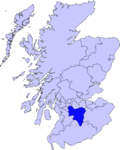| Crawford | |
|---|---|
 Crawford Castle | |
Location within South Lanarkshire | |
| OS grid reference | NS9520 |
| Council area | |
| Lieutenancy area | |
| Country | Scotland |
| Sovereign state | United Kingdom |
| Post town | BIGGAR |
| Postcode district | ML12 |
| Police | Scotland |
| Fire | Scottish |
| Ambulance | Scottish |
| UK Parliament | |
| Scottish Parliament | |
Crawford is a village and civil parish in South Lanarkshire, Scotland. [1]
Crawford is close to the source of the River Clyde and the A74(M) motorway, 50 miles (80 km) southeast of Glasgow and 53 miles (85 km) northwest of Carlisle. It has a population of around 300 people and a school.

